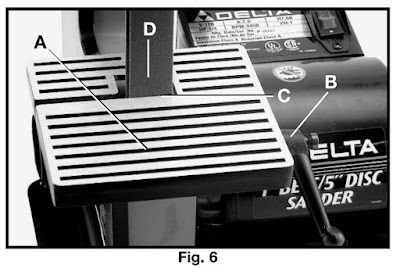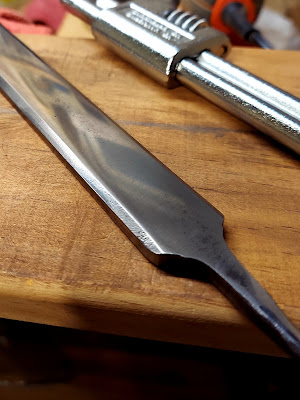Wire, Cats, French Mice and Mincemeat
For the last year or so, I've enjoyed watching YouTube videos of people restoring old tools. It's amazing how talented people can be! It's been a bit inspirational, and I thought I'd give some of it a try from time-to-time.
This ain't my first
While
House 173 is indeed almost entirely about the restoration and/or remodeling of the house, of late it's been evolving and I've included some tool restorations over time also. After all, the tools are every bit as much about the house as the projects themselves. One of my favorites is the
Gerstner Tool Chest restoration I completed in February 2020 - right before the pandemic hit our shores.


The paring chisel
Paring chisels are mostly used for cleaning out and making minor adjustments when fitting joints. "The cutting edge of the blade is sharpened to 15 to 20 degrees to enable smooth cutting. Paring chisels are designed to be moved by hand and should never be hit with a mallet since they are delicate instruments designed for fine work. They have a long handle that is attached to a tang and allows the worker maximum control," (
23 Different Types of Chisels,
Home Stratosphere).
Let's evaluate mine
Yep, that picture above is my chisel. I picked it up for a buck or two at a used tool store that (sadly) no longer exists, and I've had it for a long time but I've never used it because of its condition. But I was watching a video of
Paul Sellers making a tool the other day and he reminded me of my paring chisel, so I thought - now's the time. Here's a look:
Starting at the top, the GREEN circle points out the rust and heavy "patina" on the chisel. In the RED circle I want you to notice just how badly out of square the business end of the chisel is. And finally, the BLUE arrow points to the not insignificant chip in the cutting edge (I didn't do it!)! Clearly there's a bit of work to do!
Straightening the cutting edge
This is how bad my memory can be. I recently bought a Central Machinery bench grinder. When did you buy this machine, you ask.
Me: Recently - I can't remember exactly.
You: Which project were you working on when you bought it?
Me: I have no idea.
You: Well, certainly you can look through your pictures and figure it out!
Me: Yes! Yes! You're right! Why it looks like...umm...wait a minute - uh, hmm, I don't seem to have a picture of it before this little project.
You: [silent stare].
Me: Let's just move on.
This is definitely not my first project with the grinder, and I'm fairly comfortable with the polishing wheels on the machine, but I think this is the first time I've actually used the grinding wheels. After a couple dry runs to sort out the angle and the movement, and getting a cup of water ready (I didn't want the chisel to get too hot and ruin its hardness) it was time to alter steel!
I knew it wouldn't take long but the total grind time probably didn't exceed 10 or 15 seconds. And in those few seconds, the cutting end of the chisel was square once again!
Time for rust removal
The next big thing was to get at the rust. Because the metal ferrule on the handle met up with wood, I flattened out a soda can...
And cut a few strips...
Then duct taped a little strip of that can on the handle - because the wire wheel would make mincemeat out of the wood in no time flat. Now I was ready for the wire wheel on the grinder to get the worst of the rust off, a step which took less than 5 minutes.
It's amazing how fast the wire wheel can remove the worst of the rust, but to refine the look and add some shine, there's no way to avoid sanding. That's where the belt sander comes in!
The belt sander
A fun thing to note - this is the project wherein I learned so much about using my belt/disc sander. I'll explain as I go...So here's the sander in its normal configuration:
First, just let me say I learned most of what I'm about to describe by watching this guy on YouTube whose handle is
Scoutcrafter. He has a few hundred videos, most of which show him restoring old tools and explaining the what's, how's and why's as he goes. Go ahead and check out his page, just be sure to come back!
Thanks for coming back! So, the first thing I did was remove the table ("A" in the table above) in front of the belt. This would give me so much more freedom in moving the chisel around. The next thing was to remove the platen, which normally gives you something to press against. But I figured I'd like to get better at using this tool so why not dive in!
Then pretty much all that was left was to remove the cover that hides the pulleys and the belt as it passes through the machine. I quickly learned the prudence in removing the cover - the process of restoring the chisel involved working the steel through several different belts of varying grits. Removing and replacing that cover just seems so unnecessary.
Then it was time to just get going.
Gittin' Shiny!
Rust removed, sander all set, it was time to make this chisel shiny! The path to shiny after rust removal was through several, progressively higher grits of sanding belts. Before I even got to this point, I ordered a bunch of belts going from 220 grit all the way up to 1000 grit.
Earlier when I wrote that the grinding wheel would make mincemeat out of the wood handle, I had a flashback to Saturday mornings watching Klondike Kat cartoons. Here's a reminder (or introduction): Klondike Kat is always in pursuit of Savoir-Faire, a French-Canadian mouse who constantly steals food and is known for his catch phrase, "Savoir-Faire is everywhere!" Klondike lives in Fort Frazzle and answers to the British Canadian commanding officer Major Minor.

Though well-meaning, Klondike is naturally incompetent and usually causes more trouble than Savoir-Faire in trying to stop him ("I'll make mincemeat out of that mouse!"); yet, at the end of almost each episode, Klondike would "get his mouse" somehow ("Klondike Kat always gets his mouse."). - from Fandom
One thing I learned for certain is - start with a high grit first. If that's sufficient, it'll save a lot of time. I started with 240 grit on a tool that has some rust and some patina. 240 left some not insignificant scratches that forced me to work my way up to 1000 grit, when in fact I probably could have started with 600 grit. Nonetheless, you can see that it worked out. This picture is right about the time I had worked up to 800 grit.
By the time I made it to 1000 grit, the old paring chisel was looking a lot different. Notice that by now the chisel actually shows reflection!
Polishing and Done!
It took me a bit longer than it probably needed to for me to get the metals nice and shiny, but I wanted to experiment a bit, so I had to re-do the steel a couple times, but the education is priceless. Here you can see the chisel and the ferrule are pretty shiny. Oh, and see that little shaving of wood just below the chisel, keep that in mind for a minute.
I used some boiled linseed oil to moisturize the handle, and used that little wood-shaving as a shim to tighten the chisel tang in the handle.
Then I put on a few coats of paste wax to help stop the chisel from rusting again. As you can see, the chisel isn't quite a mirror finish, but it's a whole lot better than it was!
And just like that, the project was done. It was really fun learning how to restore a little piece like this, and get a chance to practice on the belt sander. Now the paring chisel is resting nicely in it's natural habitat in the chisel drawer!
Thanks so much for stopping by!!
Stay safe out there!



























